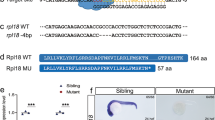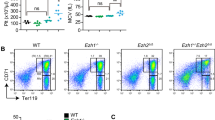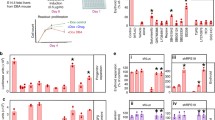Abstract
Diamond-Blackfan anemia (DBA) is a congenital erythroid hypoplasia caused by haploinsufficiency of genes encoding ribosomal proteins (RPs). Perturbed ribosome biogenesis in DBA has been shown to induce a p53-mediated ribosomal stress response. However, the mechanisms of p53 activation and its relevance for the erythroid defect remain elusive. Previous studies have indicated that activation of p53 is caused by the inhibition of mouse double minute 2 (Mdm2), the main negative regulator of p53, by the 5S ribonucleoprotein particle (RNP). Meanwhile, it is not clear whether this mechanism solely mediates the p53-dependent component found in DBA. To approach this question, we crossed our mouse model for RPS19-deficient DBA with Mdm2C305F knock-in mice that have a disrupted 5S RNP–Mdm2 interaction. Upon induction of the Rps19 deficiency, Mdm2C305F reversed the p53 response and improved expansion of hematopoietic progenitors in vitro, and ameliorated the anemia in vivo. Unexpectedly, disruption of the 5S RNP–Mdm2 interaction also led to selective defect in erythropoiesis. Our findings highlight the sensitivity of erythroid progenitor cells to aberrations in p53 homeostasis mediated by the 5S RNP–Mdm2 interaction. Finally, we provide evidence indicating that physiological activation of the 5S RNP-Mdm2-p53 pathway may contribute to functional decline of the hematopoietic system in a cell-autonomous manner over time.
This is a preview of subscription content, access via your institution
Access options
Subscribe to this journal
Receive 12 print issues and online access
$259.00 per year
only $21.58 per issue
Buy this article
- Purchase on Springer Link
- Instant access to full article PDF
Prices may be subject to local taxes which are calculated during checkout





Similar content being viewed by others
References
Willig TN, Niemeyer CM, Leblanc T, Tiemann C, Robert A, Budde J et al. Identification of new prognosis factors from the clinical and epidemiologic analysis of a registry of 229 Diamond-Blackfan anemia patients. DBA group of Société d'Hématologie et d'Immunologie Pédiatrique (SHIP), Gesellshaft für Pädiatrische Onkologie und Hämatologie (GPOH), and the European Society for Pediatric Hematology and Immunology (ESPHI). Pediatr Res 1999; 46: 553–561.
Lipton JM, Atsidaftos E, Zyskind I, Vlachos A . Improving clinical care and elucidating the pathophysiology of Diamond Blackfan anemia: an update from the Diamond Blackfan Anemia Registry. Pediatr Blood Cancer 2006; 46: 558–564.
Vlachos A, Rosenberg PS, Atsidaftos E, Alter BP, Lipton JM . Incidence of neoplasia in Diamond Blackfan anemia: a report from the Diamond Blackfan Anemia Registry. Blood 2012; 119: 3815–3819.
Draptchinskaia N, Gustavsson P, Andersson B, Pettersson M, Willig TN, Dianzani I et al. The gene encoding ribosomal protein S19 is mutated in Diamond-Blackfan anaemia. Nat Genet 1999; 21: 169–175.
Gazda HT, Grabowska A, Merida-Long LB, Latawiec E, Schneider HE, Lipton JM et al. Ribosomal protein S24 gene is mutated in Diamond-Blackfan anemia. Am J Hum Genet 2006; 79: 1110–1118.
Cmejla R, Cmejlova J, Handrkova H, Petrak J, Pospisilova D . Ribosomal protein S17 gene (RPS17) is mutated in Diamond-Blackfan anemia. Hum Mutat 2007; 28: 1178–1182.
Farrar JE, Nater M, Caywood E, McDevitt MA, Kowalski J, Takemoto CM et al. Abnormalities of the large ribosomal subunit protein, Rpl35A, in diamond-blackfan anemia. Blood 2008; 112: 1582–1592.
Gazda HT, Sheen MR, Vlachos A, Choesmel V, O’Donohue MF, Schneider H et al. Ribosomal protein L5 and L11 mutations are associated with cleft palate and abnormal thumbs in Diamond-Blackfan anemia patients. Am J Hum Genet 2008; 83: 769–780.
Doherty L, Sheen MR, Vlachos A, Choesmel V, O’Donohue MF, Clinton C et al. Ribosomal protein genes RPS10 and RPS26 are commonly mutated in Diamond-Blackfan anemia. Am J Hum Genet 2010; 86: 222–228.
Gazda HT, Preti M, Sheen MR, O’Donohue MF, Vlachos A, Davies SM et al. Frameshift mutation in p53 regulator RPL26 is associated with multiple physical abnormalities and a specific pre-ribosomal RNA processing defect in diamond-blackfan anemia. Hum Mutat 2012; 33: 1037–1044.
Landowski M, O’Donohue MF, Buros C, Ghazvinian R, Montel-Lehry N, Vlachos A et al. Novel deletion of RPL15 identified by array-comparative genomic hybridization in Diamond-Blackfan anemia. Hum Genet 2013; 132: 1265–1274.
McGowan KA, Li JZ, Park CY, Beaudry V, Tabor HK, Sabnis AJ et al. Ribosomal mutations cause p53-mediated dark skin and pleiotropic effects. Nat Genet 2008; 40: 963–970.
Danilova N, Sakamoto KM, Lin S . Ribosomal protein S19 deficiency in zebrafish leads to developmental abnormalities and defective erythropoiesis through activation of p53 protein family. Blood 2008; 112: 5228–5237.
Dutt S, Narla A, Lin K, Mulally A, Abayasekara N, Megerdichian C et al. Haploinsufficiency for ribosomal protein genes causes selective activation of p53 in human erythroid progenitor cells. Blood 2011; 117: 2567–2576.
Jaako P, Flygare J, Olsson K, Quere R, Ehinger M, Henson A et al. Mice with ribosomal protein S19 deficiency develop bone marrow failure and symptoms like patients with Diamond-Blackfan anemia. Blood 2011; 118: 6087–6096.
Vousden KH, Lu X . Live or let die: the cell’s response to p53. Nat Rev Cancer 2002; 2: 594–604.
Vousden KH, Prives C . Blinded by the light: the growing complexity of p53. Cell 2009; 137: 413–431.
Zhang Y, Lu H . Signaling to p53: ribosomal proteins find their way. Cancer Cell 2009; 16: 369–377.
Fumagalli S, Ivanenkov VV, Teng T, Thomas G . Suprainduction of p53 by disruption of 40S and 60S ribosome biogenesis leads to the activation of a novel G2/M checkpoint. Genes Dev 2012; 26: 1028–1040.
Bursać S, Brdovcak MC, Pfannkuchen M, Orsolic I, Golomb L, Zhu Y et al. Mutual protection of ribosomal proteins L5 and L11 from degradation is essential for p53 activation upon ribosomal biogenesis stress. Proc Natl Acad Sci USA 2012; 109: 20467–20472.
Donati G, Peddigari S, Mercer CA, Thomas G . 5S ribosomal RNA is an essential component of a nascent ribosomal precursor complex that regulates the Hdm2-p53 checkpoint. Cell Rep 2013; 4: 87–98.
Sloan KE, Bohnsack MT, Watkins NJ . The 5S RNP couples p53 homeostasis to ribosome biogenesis and nucleolar stress. Cell Rep 2013; 5: 237–247.
Macias E, Jin A, Deisenroth C, Bhat K, Mao H, Lindström MS et al. An ARF-independent c-MYC-activated tumor suppressor pathway mediated by ribosomal protein-Mdm2 interaction. Cancer Cell 2010; 18: 231–243.
Lindstrom MS, Jin A, Deisenroth C, White Wolf G, Zhang Y . Cancer-associated mutations in the MDM2 zinc finger domain disrupt ribosomal protein interaction and attenuate MDM2-induced p53 degradation. Mol Cell Biol 2007; 27: 1056–1068.
Jaako P, Debnath S, Olsson K, Bryder D, Flygare J, Karlsson S . Dietary L-leucine improves the anemia in a mouse model for Diamond-Blackfan anemia. Blood 2012; 120: 2225–2228.
Jaako P, Debnath S, Olsson K, Modlich U, Rothe M, Schambach A et al. Gene therapy cures the anemia and lethal bone marrow failure in a mouse model for RPS19-deficient Diamond-Blackfan anemia. Haematologica 2014; 99: 1792–1798.
Payne EM, Virgilio M, Narla A, Sun H, Levine M, Paw BH et al. L-Leucine improves the anemia and developmental defects associated with Diamond-Blackfan anemia and del(5q) MDS by activating the mTOR pathway. Blood 2012; 120: 2214–2224.
Idol RA, Robledo S, Du HY, Crimmins DL, Wilson DB, Ladenson JH et al. Cells depleted for RPS19, a protein associated with Diamond Blackfan Anemia, show defects in 18S ribosomal RNA synthesis and small ribosomal subunit production. Blood Cells Mol Dis 2007; 39: 35–43.
TeKippe M, Harrison DE, Chen J . Expansion of hematopoietic stem cell phenotype and activity in Trp53-null mice. Exp Hematol 2003; 31: 521–527.
Liu Y, Elf SE, Miyata Y, Sashida G, Liu Y, Huang G et al. p53 regulates hematopoietic stem cell quiescence. Cell Stem Cell 2009; 4: 37–48.
Dykstra B, Olthof S, Schreuder J, Ritsema M, de Haan G . Clonal analysis reveals multiple functional defects of aged murine hematopoietic stem cells. J Exp Med 2011; 208: 2691–2703.
Signer RA, Montecine-Rodriquez E, Witte ON, Dorshkind K . Aging and cancer resistance in lymphoid progenitors are linked processes conferred by p16Ink4a and Arf. Genes Dev 2008; 22: 3115–3120.
Acknowledgements
This work was supported by The Swedish Children’s Cancer Society (PJ, SK), The Crafoord Foundation (PJ), The Gunnar Nilsson Cancer Foundation (DB, PJ), The Swedish Research Council (MSL, SK), The Swedish Cancer Society (SK), Hemato-Linné grant (Swedish Research Council Linnaeus), The Tobias Prize awarded by The Royal Swedish Academy of Sciences financed by The Tobias Foundation (SK) and the EU project grants STEMEXPAND and PERSIST (SK).
Author information
Authors and Affiliations
Corresponding author
Ethics declarations
Competing interests
The authors declare no conflict of interest.
Additional information
Supplementary Information accompanies this paper on the Leukemia website
Supplementary information
Rights and permissions
About this article
Cite this article
Jaako, P., Debnath, S., Olsson, K. et al. Disruption of the 5S RNP–Mdm2 interaction significantly improves the erythroid defect in a mouse model for Diamond-Blackfan anemia. Leukemia 29, 2221–2229 (2015). https://doi.org/10.1038/leu.2015.128
Received:
Revised:
Accepted:
Published:
Issue Date:
DOI: https://doi.org/10.1038/leu.2015.128
This article is cited by
-
Rare ribosomopathies: insights into mechanisms of cancer
Nature Reviews Cancer (2019)
-
Ribosome assembly coming into focus
Nature Reviews Molecular Cell Biology (2019)
-
Induction of the 5S RNP–Mdm2–p53 ribosomal stress pathway delays the initiation but fails to eradicate established murine acute myeloid leukemia
Leukemia (2017)
-
Nucleolus-derived mediators in oncogenic stress response and activation of p53-dependent pathways
Histochemistry and Cell Biology (2016)



